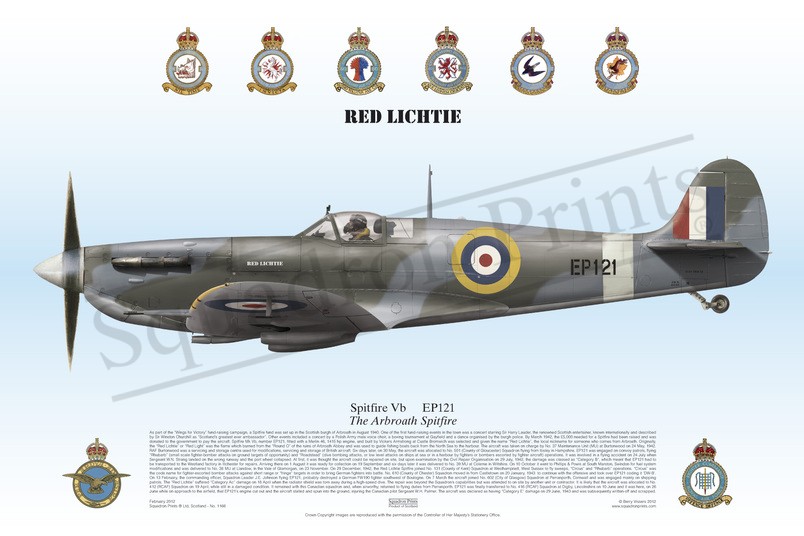#1166 Spitfire Vb

Purchased products will not feature the Squadron Prints watermark
Description
Squadron Prints Lithograph No. 1166 - Spitfire Vb, EP121, The Arbroath Spitfire \"RED LICHTIE\".
As part of the “Wings for Victory” fund-raising campaign, a Spitfire fund was set up in the Scottish burgh of Arbroath in August 1940. One of the first fund-raising events in the town was a concert starring Sir Harry Lauder, the renowned Scottish entertainer, known internationally and described by Sir Winston Churchill as “Scotland’s greatest ever ambassador”. Other events included a concert by a Polish Army male voice choir, a boxing tournament at Gayfield and a dance organised by the burgh police. By March 1942, the £5,000 needed for a Spitfire had been raised and was donated to the government to pay the aircraft. Spitfire Mk Vb, number EP121, fitted with a Merlin 46, 1415 hp engine, and built by Vickers Armstrong at Castle Bromwich was selected and given the name “Red Lichtie”, the local nickname for someone who comes from Arbroath. Originally, the “Red Lichtie” or “Red Light” was the flame which burned from the “Round O” of the ruins of Arbroath Abbey and was used to guide fishing boats back from the North Sea to the harbour. The aircraft was taken on charge by No. 37 Maintenance Unit (MU) at Burtonwood on 24 May, 1942. RAF Burtonwood was a servicing and storage centre used for modifications, servicing and storage of British aircraft. Six days later, on 30 May, the aircraft was allocated to No. 501 (County of Gloucester) Squadron flying from Ibsley in Hampshire. EP121 was engaged on convoy patrols, flying “Rhubarb” (small scale fighter-bomber attacks on ground targets of opportunity) and “Roadstead” (dive bombing attacks, or low level attacks on ships at sea or in a harbour by fighters or bombers escorted by fighter aircraft) operations. It was involved in a flying accident on 24 July when Sergeant W.N. Strang landed on the wrong runway and the port wheel collapsed. At first, it was thought the aircraft could be repaired on site, but upon examination by the Civil Repair Organisation on 29 July, 1942, the damage was classed as “Category B”, which meant that EP121 had to be transported to the Westland factory in Illchester for repairs. Arriving there on 1 August it was ready for collection on 19 September and six days later it was delivered to No. 39 MU at Colerne in Wiltshire. On 10 October it went to Phillips & Powis at South Marston, Swindon for fuel system modifications and was delivered to No. 38 MU at Llandow, in the Vale of Glamorgan, on 23 November. On 29 December, 1942, the Red Lichtie Spitfire joined No. 131 (County of Kent) Squadron at Westhampnett, West Sussex to fly sweeps, “Circus” and “Rhubarb” operations. “Circus” was the code name for fighter-escorted bomber attacks against short range or “fringe” targets in order to bring German fighters into battle. No. 610 (County of Chester) Squadron moved in from Castletown on 20 January, 1943 to continue with the offensive and took over EP121 coding it ‘DW-B’. On 13 February, the commanding officer, Squadron Leader J.E. Johnson flying EP121, probably destroyed a German FW190 fighter southwest of Boulogne. On 7 March the aircraft joined No. 602 (City of Glasgow) Squadron at Perranporth, Cornwall and was engaged mainly on shipping patrols. The “Red Lichtie” suffered “Category Ac” damage on 18 April when the radiator shield was torn away during a high-speed dive. The repair was beyond the Squadron’s capabilities but was attended to on site by another unit or contractor. It is likely that the aircraft was allocated to No. 412 (RCAF) Squadron on 19 April, while still in a damaged condition. It remained with this Canadian squadron and, when airworthy, returned to flying duties from Perranporth. EP121 was finally transferred to No. 416 (RCAF) Squadron at Digby, Lincolnshire on 10 June and it was here, on 26 June while on approach to the airfield, that EP121’s engine cut out and the aircraft stalled and spun into the ground, injuring the Canadian pilot Sergeant W.H. Palmer. The aircraft was declared as having “Category E” damage on 29 June, 1943 and was subsequently written-off and scrapped.
